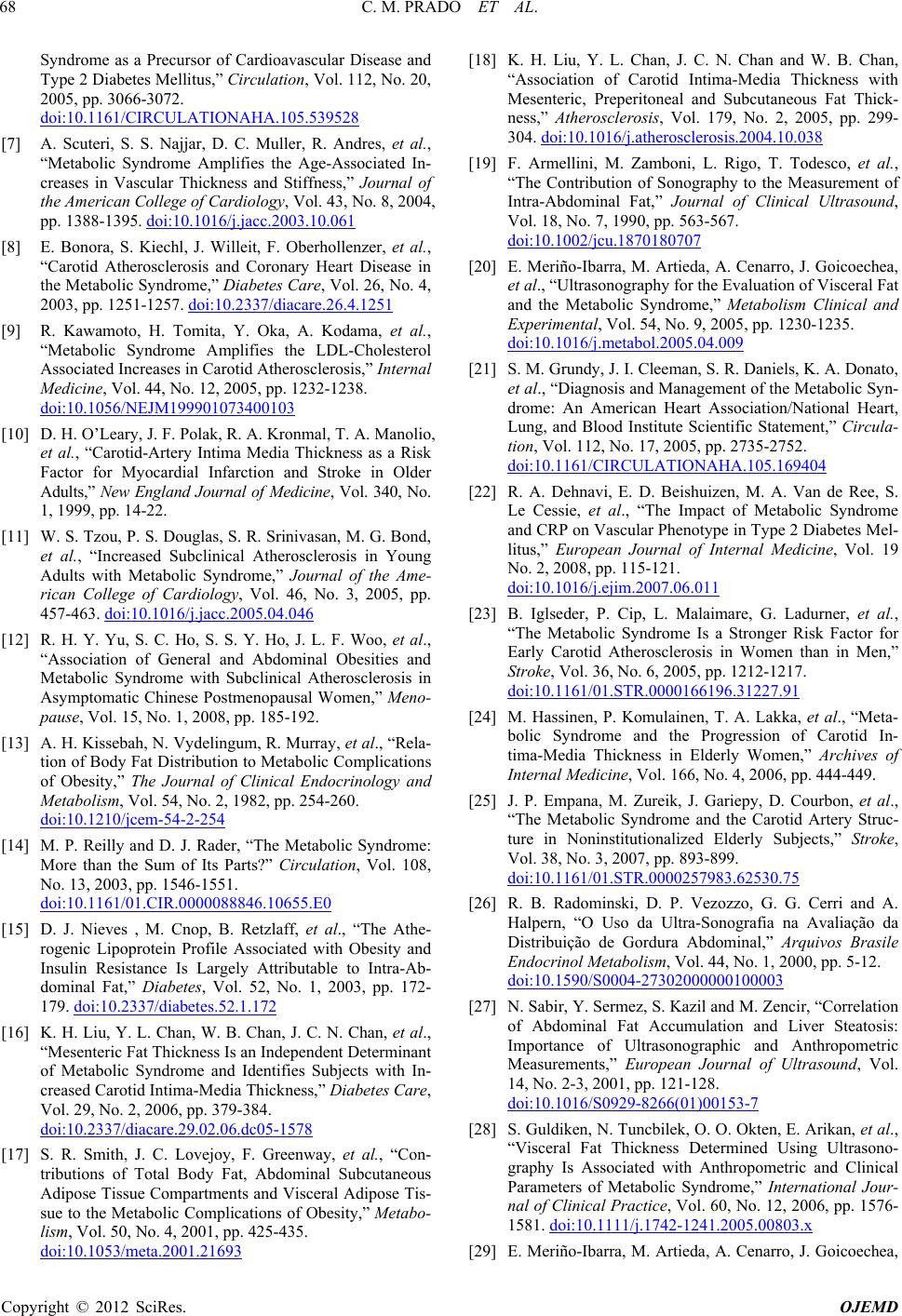
C. M. PRADO ET AL.
68
Syndrome as a Precursor of Cardioavascular Disease and
Type 2 Diabetes Mellitus,” Circulation, Vol. 112, No. 20,
2005, pp. 3066-3072.
doi:10.1161/CIRCULATIONAHA.105.539528
[7] A. Scuteri, S. S. Najjar, D. C. Muller, R. Andres, et al.,
“Metabolic Syndrome Amplifies the Age-Associated In-
creases in Vascular Thickness and Stiffness,” Journal of
the American College of Cardiology, Vol. 43, No. 8, 2004,
pp. 1388-1395. doi:10.1016/j.jacc.2003.10.061
[8] E. Bonora, S. Kiechl, J. Willeit, F. Oberhollenzer, et al.,
“Carotid Atherosclerosis and Coronary Heart Disease in
the Metabolic Syndrome,” Diabetes Care, Vol. 26, No. 4,
2003, pp. 1251-1257. doi:10.2337/diacare.26.4.1251
[9] R. Kawamoto, H. Tomita, Y. Oka, A. Kodama, et al.,
“Metabolic Syndrome Amplifies the LDL-Cholesterol
Associated Increases in Carotid Atherosclerosis,” Internal
Medicine, Vol. 44, No. 12, 2005, pp. 1232-1238.
doi:10.1056/NEJM199901073400103
[10] D. H. O’Leary, J. F. Polak, R. A. Kronmal, T. A. Manolio,
et al., “Carotid-Artery Intima Media Thickness as a Risk
Factor for Myocardial Infarction and Stroke in Older
Adults,” New England Journal of Medicine, Vol. 340, No.
1, 1999, pp. 14-22.
[11] W. S. Tzou, P. S. Douglas, S. R. Srinivasan, M. G. Bond,
et al., “Increased Subclinical Atherosclerosis in Young
Adults with Metabolic Syndrome,” Journal of the Ame-
rican College of Cardiology, Vol. 46, No. 3, 2005, pp.
457-463. doi:10.1016/j.jacc.2005.04.046
[12] R. H. Y. Yu, S. C. Ho, S. S. Y. Ho, J. L. F. Woo, et al.,
“Association of General and Abdominal Obesities and
Metabolic Syndrome with Subclinical Atherosclerosis in
Asymptomatic Chinese Postmenopausal Women,” Meno-
pause, Vol. 15, No. 1, 2008, pp. 185-192.
[13] A. H. Kissebah, N. Vydelingum, R. Murray, et al., “Rela-
tion of Body Fat Distribution to Metabolic Complications
of Obesity,” The Journal of Clinical Endocrinology and
Metabolism, Vol. 54, No. 2, 1982, pp. 254-260.
doi:10.1210/jcem-54-2-254
[14] M. P. Reilly and D. J. Rader, “The Metabolic Syndrome:
More than the Sum of Its Parts?” Circulation, Vol. 108,
No. 13, 2003, pp. 1546-1551.
doi:10.1161/01.CIR.0000088846.10655.E0
[15] D. J. Nieves , M. Cnop, B. Retzlaff, et al., “The Athe-
rogenic Lipoprotein Profile Associated with Obesity and
Insulin Resistance Is Largely Attributable to Intra-Ab-
dominal Fat,” Diabetes, Vol. 52, No. 1, 2003, pp. 172-
179. doi:10.2337/diabetes.52.1.172
[16] K. H. Liu, Y. L. Chan, W. B. Chan, J. C. N. Chan, et al.,
“Mesenteric Fat Thickness Is an Independent Determinant
of Metabolic Syndrome and Identifies Subjects with In-
creased Carotid Intima-Media Thickness,” Diabetes Care,
Vol. 29, No. 2, 2006, pp. 379-384.
doi:10.2337/diacare.29.02.06.dc05-1578
[17] S. R. Smith, J. C. Lovejoy, F. Greenway, et al., “Con-
tributions of Total Body Fat, Abdominal Subcutaneous
Adipose Tissue Compartments and Visceral Adipose Tis-
sue to the Metabolic Complications of Obesity,” Metabo-
lism, Vol. 50, No. 4, 2001, pp. 425-435.
doi:10.1053/meta.2001.21693
[18] K. H. Liu, Y. L. Chan, J. C. N. Chan and W. B. Chan,
“Association of Carotid Intima-Media Thickness with
Mesenteric, Preperitoneal and Subcutaneous Fat Thick-
ness,” Atherosclerosis, Vol. 179, No. 2, 2005, pp. 299-
304. doi:10.1016/j.atherosclerosis.2004.10.038
[19] F. Armellini, M. Zamboni, L. Rigo, T. Todesco, et al.,
“The Contribution of Sonography to the Measurement of
Intra-Abdominal Fat,” Journal of Clinical Ultrasound,
Vol. 18, No. 7, 1990, pp. 563-567.
doi:10.1002/jcu.1870180707
[20] E. Meriño-Ibarra, M. Artieda, A. Cenarro, J. Goicoechea,
et al., “Ultrasonography for the Evaluation of Visceral Fat
and the Metabolic Syndrome,” Metabolism Clinical and
Experimental, Vol. 54, No. 9, 2005, pp. 1230-1235.
doi:10.1016/j.metabol.2005.04.009
[21] S. M. Grundy, J. I. Cleeman, S. R. Daniels, K. A. Donato,
et al., “Diagnosis and Management of the Metabolic Syn-
drome: An American Heart Association/National Heart,
Lung, and Blood Institute Scientific Statement,” Circula-
tion, Vol. 112, No. 17, 2005, pp. 2735-2752.
doi:10.1161/CIRCULATIONAHA.105.169404
[22] R. A. Dehnavi, E. D. Beishuizen, M. A. Van de Ree, S.
Le Cessie, et al., “The Impact of Metabolic Syndrome
and CRP on Vascular Phenotype in Type 2 Diabetes Mel-
litus,” European Journal of Internal Medicine, Vol. 19
No. 2, 2008, pp. 115-121.
doi:10.1016/j.ejim.2007.06.011
[23] B. Iglseder, P. Cip, L. Malaimare, G. Ladurner, et al.,
“The Metabolic Syndrome Is a Stronger Risk Factor for
Early Carotid Atherosclerosis in Women than in Men,”
Stroke, Vol. 36, No. 6, 2005, pp. 1212-1217.
doi:10.1161/01.STR.0000166196.31227.91
[24] M. Hassinen, P. Komulainen, T. A. Lakka, et al., “Meta-
bolic Syndrome and the Progression of Carotid In-
tima-Media Thickness in Elderly Women,” Archives of
Internal Medicine, Vol. 166, No. 4, 2006, pp. 444-449.
[25] J. P. Empana, M. Zureik, J. Gariepy, D. Courbon, et al.,
“The Metabolic Syndrome and the Carotid Artery Struc-
ture in Noninstitutionalized Elderly Subjects,” Stroke,
Vol. 38, No. 3, 2007, pp. 893-899.
doi:10.1161/01.STR.0000257983.62530.75
[26] R. B. Radominski, D. P. Vezozzo, G. G. Cerri and A.
Halpern, “O Uso da Ultra-Sonografia na Avaliação da
Distribuição de Gordura Abdominal,” Arquivos Brasile
Endocrinol Metabolism, Vol. 44, No. 1, 2000, pp. 5-12.
doi:10.1590/S0004-27302000000100003
[27] N. Sabir, Y. Sermez, S. Kazil and M. Zencir, “Correlation
of Abdominal Fat Accumulation and Liver Steatosis:
Importance of Ultrasonographic and Anthropometric
Measurements,” European Journal of Ultrasound, Vol.
14, No. 2-3, 2001, pp. 121-128.
doi:10.1016/S0929-8266(01)00153-7
[28] S. Guldiken, N. Tuncbilek, O. O. Okten, E. Arikan, et al.,
“Visceral Fat Thickness Determined Using Ultrasono-
graphy Is Associated with Anthropometric and Clinical
Parameters of Metabolic Syndrome,” International Jour-
nal of Clinical Practice, Vol. 60, No. 12, 2006, pp. 1576-
1581. doi:10.1111/j.1742-1241.2005.00803.x
[29] E. Meriño-Ibarra, M. Artieda, A. Cenarro, J. Goicoechea,
Copyright © 2012 SciRes. OJEMD